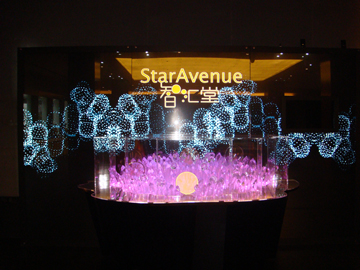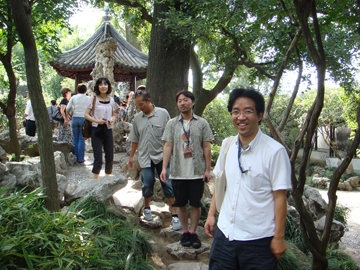Meeting report from the 2010 Cold Spring Harbor Asia Conference “Molecular Switches and Genome Function in Stem Cells and Development”
Posted by mikhalych, on 3 February 2011
In 2010 Cold Spring Harbor Laboratories building upon the success of its educational programs established an equivalent program in Asia and Pacific Rim centered in Suzhou, China – Cold Spring Harbor Conferences Asia (CSHCA). This development echoes the spectacular advances in biological research throughout the region (especially in China) over the past 30 years. The program includes large conferences, training workshops and small-scale, by-invitation meetings covering a broad spectrum of biomedical research topics as well as other fields of modern biology. It is planned that in near future the Conference Center will be supplemented by research facilities thereby creating an Asian research hub styled on the famous CSHL.
The Conference which took place on 21-25 September 2010 gathered more than 100 participants all over the world. It was set up in the new campus combining throughout ultramodern convenience and world-class architectural and landscape design beside Dushu Lake of Suzhou. Situated quite afar from the Suzhou downtown, the venue imposed tranquility suitable for consequential exchange of scientific ideas and fruitful discussions.
The central theme of the meeting was the iPS cell technology. So the Plenary Lecture delivered by Andras Nagy (Mount Sinai Hospital, Toronto) was dedicated to a closer look at the somatic cell reprogramming and consequences of the process for the stability of genome. It seems that the price we have to pay for our ability to turn almost every cell into the pluripotent one is the danger of inadvertent genomic aberrations which happen even after the retrovirus-free reprogramming. This might have quite strong implications for any therapeutic use of iPS cells in future. Nevertheless, the attempts to use iPSC for medical purposes were reported by researchers from Duanqing Pei’s lab (Guangzhou Institutes of Biomedicine and Health, GIBH). One application was the modeling of human syndromes in human iPSC for test the gene therapy approaches and screening chemical compounds with the potential to correct an abnormality (in collaboration with Miguel Esteban, GIBH, and Axel Schambach, Hannover Medical School). Pentao Liu (Wellcome Trust Sanger Institute, Cambridge, UK) reported his lab’s work on identification of two additional genetic factors which dramatically improve and shorten the reprogramming process when used with four Yamanaka factors. Interesting evolutionary aspect of Sox2 function in pluripotent cell was demonstrated by Hitoshi Niwa (CDB, RIKEN Kobe); he suggested that a new function of the critical transcription factor may arise in evolution without structural changes in the molecule.
Many oral presentations were dedicated also to various adult stem cell systems, and the talk of Nick Barker (Hubrecht Institute, Utrecht) on intestinal crypt stem cells was in the focus of the meeting’s interest. In addition to revealing the key role of Lrg5 (Tcf/β-catenin target) in maintaining self-renewal of intestinal stem cells, he demonstrated an intriguing aspect of stem cell function – competition of stem cells within their niche. Quite a surprise, probably for many participants, was the presentation of Richard P. Harvey (Victor Chang Cardiac Research Institute, Australia) about the presence of multipotent stem cells (CFU-Fs) in adult mammalian heart. George C. Yeoh (University of Western Australia) addressed the recurrent and controversial issue of liver stem cells, describing inflammation-induced LPC, liver progenitor cells, which rapidly proliferate in vitro, survive repeated cycles of freezing/thawing and capable to differentiate into at least two types of liver cells: hepatocytes and cholangiocytes. Toshio Suda (Keio University, Tokyo) elaborated further on his theme of the hypoxic niche for hematopoietic stem cells (HSCs). It turns out that HSCs require a precise regulation of HIF-1α levels in order to maintain their quiescence in adult bone marrow. Interesting findings on the role of hemogenic endothelium in the ontogenesis of HSCs were presented by members of Shin-Ichi Nishikawa laboratory (CDB, RIKEN Kobe).
Practically all other oral presentations communicated the results of very impressive research. Among them most memorable were the addressing the role of stem cells in prostate cancer by Michael Shen (Columbia University Medical Center, New York), and latest insights on germ cell specification in vivo and in vitro (Mitinori Saitou, Graduate School of Medicine, Kyoto University).
Coffee breaks and lobby talks (sometimes with local beer tasting) proved to be exceptionally productive for friendly discussions, deeper insight into the presented works and, perhaps, for carrier opportunities for young Chinese researchers. Well, since the Chinese Ministry of Science and Technology has been reported to have established the National Key Program on stem cells (with large funding of corresponding research) in 2010, some foreign scientists may ponder the idea to move to China and set up their research there.
The Conference culminated in visiting the famous Lingering Garden of Suzhou, a UNESCO World Heritage Site. Artist performances, classical Chinese singing and dancing added a historical dimension to the vigor and intellectual strength of modern China.





 (3 votes)
(3 votes)